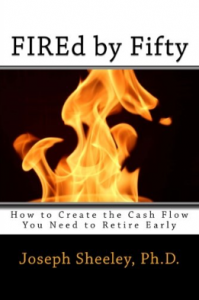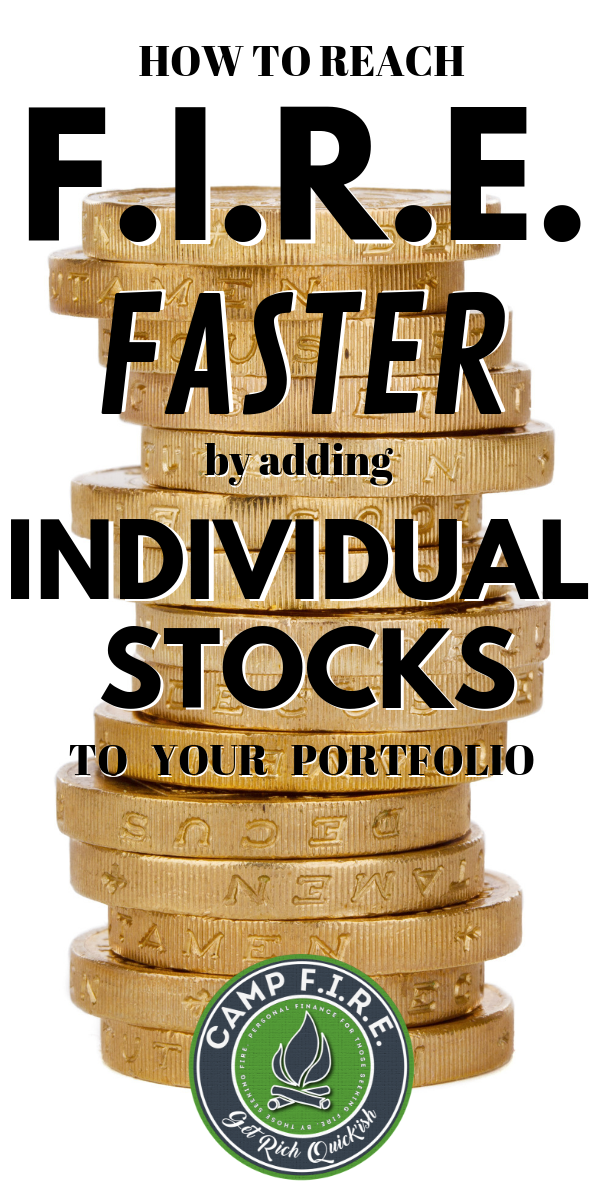
How Investing in Individual Stocks Can Help Get You FIREd

We’ve all heard the conventional wisdom on investing: Invest only using index mutual funds. 90% of professional mutual fund managers fail to beat their benchmark. What chance does an individual investor have?
Surprisingly, when it comes to stock picking, small investors do have a huge advantage over professional money managers. The main reason is size. Mutual fund managers, if they are successful, end up with a lot of money to invest – billions of dollars, in fact. If they are good stock pickers, they might very well be able to pick more winners than losers. If they were provided with a million dollars, they could come out ahead of their benchmarks.
How Investing in Individual Stocks Can Help You get FIREd by Fifty
But the issue is that they have billions of dollars to invest. If they were to just invest in their top picks, they would end up buying all of the shares in the companies they chose, driving the share price to astronomical levels when they did so. When they sold, just the opposite would occur. They would flood the market with shares and drive down prices. Look at what happened to internet stocks in 1999 and 2000 to see what happens when 90% of the shares in a company that were locked up are suddenly released.
So, instead of just buying their top choice in each sector, they buy their first, second, third, fourth, and, maybe, fifth choice. This means they’ve bought Coke, Pepsi, Dr. Pepper and Mellow Yellow. Maybe Coke stock does a lot better than Pepsi, but they own both companies, so they get just the average return. This means that they start getting returns that look an awful lot like what their benchmarks are providing. Once you pay for the managers’ salaries, staffs, research, and first class travel to attend all of those company meetings they attend looking for ideas, the investor ends up doing worse in a managed fund than an index.
Know When to Hold Em
The other issue is that professional managers are judged on performance constantly, with the performance report coming out each quarter scrutinized. Because investors go to Morningstar and look at how many stars a fund has, and because stars are based on how well the fund did versus its peers, active managers are always trying to find the stocks that will do well over the next year, not what will do well over the next ten years. This keeps them from buying great stocks and holding onto them through the downturns, which is how big gains are made.
Some managers even buy the stocks that have done well during the year, after they have already gone up in price, so that they’ll have those stocks in their portfolio when the next annual report comes out. After the report is released, they sell off the positions, causing their fund expenses to go up.
It’s Good to be Small if you Want to Become FIRE
Small investors do not need to spread out their investments because they are not going to move the stock price when they buy and sell. Likewise, they don’t need to show good performance each year, so they can pick their favorites and then just wait for the companies to grow and prosper. They don’t need to be right about the timing. If they buy and the stock price dips a bit, they can just buy more at lower prices and wait. It is much easier to pick a stock that will do well sometime in the next ten years than it is to find a stock that will do well this year. These are huge advantages that the individual investor has over the pros.
If you’re hoping to become financially independent and retire early (FIRE), adding a few individual stocks to your portfolio can really help you along the way. This is not to say that you should take all of your money and invest in the next big tech start-up. Index mutual funds should still form the foundation of your portfolio and greatly dominate your investments in traditional retirement plans. It is just that if you add a few, concentrated positions in a few great companies, then be ready to hold onto them for ten or twenty years to give them time to mature, you can supercharge your returns and get to FIRE that much faster.
Quantity in Quality
There are people out there, many of them, who hold large positions in a few companies that they have built up over a number of years. They may have started out with a few thousand dollars, but as the company grew and the stocks doubled and split, then doubled and split again, their position grew until it was into the hundreds of thousands of dollars. Some individuals are former employees who got stock as part of their pay package. Others are just investors who concentrated in a certain company.
I remember attending a shareholders’ meeting for Citizen’s Utilities back in the 1990s when one of the directors told the story of a shareholder who had called him up, complaining that she had held the company for more than twenty years and that the share price had not gone anywhere. What the shareholder did not realize is that the company had split its shares every couple of years for the last decade or more. Once he did the calculation, the directory was delighted to inform the disgruntled shareholder that she was, in fact, a millionaire!
Long-term positions in solid growth companies can provide the FIRE investor with similar results. A good investment can put your children through college, pay off your home, or provide the money needed for medical expenses in retirement. One of the best ways to grow wealth is to start and run a successful business. When you invest long-term, it is like you’re becoming a partner in a business, except you can choose one with an ivy-league management team and a demonstrated record of success.
You Can Beat the Markets if you get Serious
Too many people spend their time playing around when stock investing. They buy stocks based upon movements of the share price. They sell if the price drops by 5% or if the price goes up by 25%. Or they sell if they make a profit of $1000 or some such number. That kind of investing only makes stockbrokers wealthy.
 In my book, The SmallIvy Book of Investing, Book 1: Investing to Grow Wealthy, I line out what I call serious investing. Serious investing involves taking up large positions in a few select companies, the best-of-the-best. The investor then holds onto his/her positions until he/she needs the money for something, the company fundamentally changes and no longer has the desired characteristics, or the position becomes so large that an event at the company would cause serious damage to one’s finances.
In my book, The SmallIvy Book of Investing, Book 1: Investing to Grow Wealthy, I line out what I call serious investing. Serious investing involves taking up large positions in a few select companies, the best-of-the-best. The investor then holds onto his/her positions until he/she needs the money for something, the company fundamentally changes and no longer has the desired characteristics, or the position becomes so large that an event at the company would cause serious damage to one’s finances.
When you’re serious, you don’t trade very often. You don’t care about changes in the stock’s price, unless you are still accumulating shares, in which case you appreciate the lower prices after dips. You realize that you don’t need to choose stocks that will do well over the next year, but that will do well over the next decade or two, which is actually far easier.
How Get Serious
If you would like to get serious, start out by making sure you have your financial life in order. Take care of credit card debts and make sure you have a good emergency fund. Have your retirement accounts fully funded. Make sure that you are saving money for health care (in an HSA if you have one), your children’s college, major home repairs and upgrades, and cash for the next cars you will buy. Also, make sure that you have a firm foundation of index mutual funds in case you discover that you are not a good stock picker.
Learn How to Pick Stocks
Next, start to learn stock picking. There are a number of books on the topic, including classics like Peter Lynch’s One Up On Wall Street and Benjamin Graham’s The Intelligent Investor. This latter book formed the philosophy of Warren Buffett, considered by many to be the world’s best stock picker. In this case, we’re looking for stocks that are well-suited for long-term growth. Look for companies that have a great product and have a lot of room to grow. Choose about three to five stocks, each in a different industry, to form a target list. You’ll want to pick stocks with prices between $10 and $30.
Once you have a target list, save up cash until you have enough to buy 100-200 shares of one of the stocks on your target list. Go ahead and make your first purchase, picking a stock from your list that appears to be the best choice based on the price of the stock relative to your projections of what the stock could be worth in a few years. (It will take time and experience to learn how to price stocks, plus some reading and studying.)

Keep on Keepin On
Once you have made your first purchase, continue to save up cash and buy more shares from your target list. Continue building up positions in these companies until you have between 500 and 1000 shares in each. From there, simply hold onto your shares. If a position becomes very big, such that a loss of the whole position would set you way back, go ahead and sell a portion and put the money into index funds to lock in your gains. Personally, I cut a position back when it grows above about 5% of my portfolio value. Otherwise, simply continue to hold unless a company no longer appears to have room for solid growth or other factors change that makes the stock undesirable.
Putting everything in one company, particularly if it is your employer, is a bad plan. Adding a few individual stocks to a portfolio founded on diversified mutual funds can be a good idea and a way to get FIREd faster.
 Joe Sheeley, aka SmallIvy, is a rocket scientist who reached FI at age 42. He has been investing since age 12 and is the author of The SmallIvy Book of Investing and his latest book, FIREd by Fifty. He is the founder of the Small Investor Blog.
Joe Sheeley, aka SmallIvy, is a rocket scientist who reached FI at age 42. He has been investing since age 12 and is the author of The SmallIvy Book of Investing and his latest book, FIREd by Fifty. He is the founder of the Small Investor Blog.